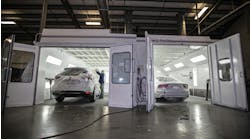How to increase your labor hours and still keep customers happy
Are you looking for a solution that will increase your gross profit margin? If so, you’re reading the right article. Let’s listen to ATI Performance Coach Don Walter explain how to do it. The answer may be very simple and right under your nose. It only requires having some basic processes in place for this to work. I’m not talking about increasing car count, gross profit or trying to save yourself into a profit. I’m talking about increasing your labor hour per invoice.
When I’m coaching shop owners around the country, a common question I’ll ask is: How is business this week? One of my members who was really struggling answered: “We are slow, I need more cars.” When I looked at his key performance indicators (KPIs) report for his shop, it told a very different story. His shop saw 60 cars that week, but had a low average repair order, low gross profit margins and low labor hours per invoice. He thought he needed more cars, but he didn’t. He actually didn’t have a car count problem at all, he had a labor hour problem.
After studying hundreds of shops with similar problems and looking at their three-year average, I found that their labor hour per invoice only varied by .20 per hour. I examined their invoices and realized that they were leaving approximately .5 to 1.5 labor hours of recommendations off every invoice. These were simple services that never made it to their invoices. What’s worse is that most of these services could have been done by an entry-level tech, which would have easily increased their gross profit margin.
|
LIMITED TIME OFFER: Courtesy Checks Consistency Guide |
| To ensure courtesy checks are being performed consistently, download ATI’s Courtesy Checks Consistency Guide by going to www.ationlinetraining.com/2020-05 for a limited time. |
How, you ask? It’s simple math. Let’s say your labor rate is $100 an hour. If you were able to sell an additional .5 hour per invoice that would be an additional $50. Considering best practices, you would also sell $50 in parts for an additional $100. So, if your shop averages 50 cars a week, that’s $5,000 more each week in sales and $250,000 each year. The WOW factor here is that we didn’t add more cars or gross profit. When doing this math with my 20 group, I discovered they were collectively leaving about $4 million on the table. My second 20 Group was leaving about $3.4 million on the table. So, in total, both groups had 7.4 million dollars of missed recommendations.
If you’re asking yourself how this can be done in your shop, the answer is simple. First, you need a good courtesy check process. It starts with your service advisors understanding your customers’ buying personality and the type of drivers they are. Second, your service advisors need to get the mileage off their vehicles, check their repair history and review their vehicles’ maintenance schedule. Third, make sure that your service advisors are presenting their service recommendations along with your customers’ requests. Fifth, make sure that all your service advisors are recommending these services consistently across the board by downloading ATI’s Courtesy Checks Consistency Guide. To be sure this is happening, I recommend that you perform daily invoice audits to find missing or inconsistent recommendations. You can use the findings from this audit for training and coaching your staff.
So how are these missed services addressed? Here’s an example: a vehicle comes into your shop that has 91,000 miles on it. Your tech does a great courtesy check and has some great recommendations but left the transmission service off the ticket. Your service advisor, after checking the history and scheduled maintenances, notices that the tech didn’t recommend it. Could you still sell it? — The answer is YES. You could just ask the customer if the transmission fluid had ever been exchanged. And, follow up that question by telling them that your records do not show that the service has been done and that the manufacturer is recommending it. If your customer approves, there’s .9 hour of labor.
Another way to increase your labor hour per invoice is to cross sell. For example, if you’re servicing an air conditioning system, you could sell a cabin air filter with that service and check if the antifreeze needs servicing. There’s .5 and .9 = 1.4 additional labor hours.
One mistake made by far too many salespeople is not cross selling — neglecting the related or maintenance sale. Your presentation, product knowledge, understanding of customer needs, etc. could be perfect, but if you don’t ask your customer for their business, your success rate will be marginal at best. Your customers are there to make a purchase. You know that, they know that, and they know that you know that. Despite this common knowledge, you might be surprised by how many people are never asked for their business. They go home to “think” about the purchase only to go to a local competitor to make the purchase. The reality is that the customer probably would have purchased your product had you simply asked for the sale.
Below are some ideas how this can be accomplished.
- Know your customers’ buying habits.
You should always request your first-time customers’ service records and should ask them about their service histories verbally as well. This information can be extremely helpful during any sales process, especially when it comes to selling maintenance. Great doctors are always interested in a patient’s medical history, just as great service advisors are always interested in a customer’s service history. This information not only indicates which maintenance services are due but will give you valuable insights into your customers’ buying habits as well.
- Have the right tools available.
People believe what they see, so whenever possible, you should get your customers visually involved. At ATI we are big supporters of complete vehicle inspections, proper documentation, and visually showing your customers what was discovered. Since third-party documentation is usually viewed as a credible source, you should use your customers’ owner’s manuals, their service records, printouts that show industry recommendations, maintenance brochures, repair orders that show the high cost of repairs, failed components and fluid samples.
- Make sure your employees understand why timely maintenance is so important.
Have all your employees conduct the ATI Smell Test then compare your answers to find a common recommendation. For those of you that are not familiar with the ATI Smell Test, create a document with all your services listed on it. Hand it out to all your internal customers and have them independently fill in what time and mileage intervals each service should be performed. Then have a shop meeting to discuss and agree upon the interval standards for your shop. Does your shop have a policy and procedure of when we recommend certain services?
- Prepare an estimate that will sell.
When presenting your estimate to your customer, always start first with their initial concern that they came in for. Next address any safety items and then present any maintenance recommendations.
- Use an assumptive close technique.
Instead of asking your customers if they would like you to perform the recommended maintenance services, you could say, “All that I’ll need is your go-ahead, and we’ll get started on it right away.” Assumptive closes send a strong message that there is no logical reason for your customers to decline the services that were recommended.
- Schedule the next appointment.
There is no better time to schedule the next appointment than at the time of car delivery. Your customers are standing in front of you, they feel comfortable with you, and it’s easy for them to say yes. If your customers leave without making an appointment, then they’re going to be fair game for all your competitors. In addition, taking good care of your customers’ vehicles is a process, not an event, so it stands to reason that you’ll need to see them again to perform the services that will be due at that time, to complete a periodic safety inspection, etc.
So, the next time you think you have a car count problem, audit your invoices before you spend money or time on marketing or other actions to increase gross profit. It may be that your labor hour per invoice is too low and that you’re leaving money on the table. You can correct this by implementing or improving your courtesy checks process and remembering to cross sell related services and items. To ensure courtesy checks are being performed consistently, download ATI’s Courtesy Checks Consistency Guide by going to www.ationlinetraining.com/2020-05 for a limited time.



